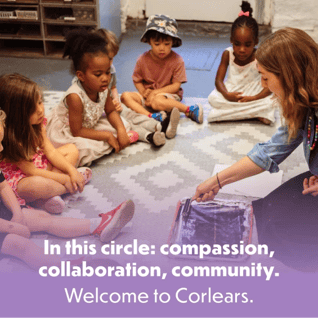Learn how Corlears School cultivates strong literacy foundations in children from a young age, developing reading and writing skills that set students up for success in upper elementary, middle school, and beyond.
At Corlears School, we believe in the importance of establishing strong literacy foundations at an early age, setting the stage for future success in reading and writing.
Starting as young as 2 years old, children at Corlears build pre-literacy skills, including phonemic awareness, alphabet knowledge, language skills (both expressive and receptive) as well as burgeoning vocabulary development. By Kindergarten, students are equipped with the necessary skills to excel in reading, writing, and speaking confidently through fifth grade and middle school.

A group of PreK students explore books together.
.png)
During Library, Seedlings students gather around to hear a story.

Preschool students advance to gripping a pencil to trace letters.
Developing Literacy Skills in Early Childhood
Before children can begin to read, they need to build pre-literacy skills. That includes building vocabulary, receptive language skills (understanding meaning of words), phonemic and phonological awareness (the sounds and relationships between letters), narrative structure and sequence, and developing fine-motor control and strength for handwriting.
In Corlears’ early childhood classrooms, children are learning in a print-rich environment, surrounded by books and images. Teachers read aloud to our young children using an interactive approach. Reading aloud is an important and meaningful way to support children in building language skills by exposing them to new words and ways of using language (visit our blog for tips on how to read aloud in an engaging, interactive way at home).
Storytelling, songs, and even puppetry are utilized throughout lessons, as well as during circle times and specialty classes like Library and Music. Throughout our Roots, Seedlings, and PreK programs, students follow along with a visual schedule of the day to teach sequence.
Even before they can write letters or spell words, toddlers are learning to express themselves through writing and drawing. Through mark-making on paper and vertical surfaces with various materials (including markers, crayons, dot markers, paint, brushes, and more), these young students are building the strength and skills to write.

A Corlears Seedlings teacher reads aloud to a group of children.
-2.png)
A nursery school student flips through a book independently.

Young children develop the fine motor skills and strength needed to write through mark-making.
Reading Skills Development in Kindergarten
We know from research that we don’t have to wait until first grade to begin teaching students how to read. Our elementary program incorporates the best practices outlined by the Science of Reading approach to teach literacy from Kindergarten through fifth grade.
In Kindergarten, our young readers are tasked with strengthening their phonemic awareness, which is the ability to identify and manipulate individual sounds of the English language. Students are explicitly taught the predictable relationship between symbols and sounds, and at the same time, they are being introduced to literature that will help build their comprehension skills.
In addition to these foundational skills, we also focus on developing fine-motor skills through activities such as drawing and guided writing. By teaching children how to hold writing tools correctly and allowing them to trace and write their names and simple words, we are setting them up for success in later reading and writing activities.
At this age, they are engaging in rich comprehension conversations, as a whole group and in partnerships. They are also responding to literature in writing and being given the opportunity to write their own stories. By the end of Kindergarten at Corlears, students are able to read emergent texts independently.

A Kindergartener illustrates a narrative and practices gripping a pencil.

Kindergarten students identifying the words that start with S.

Students took a field trip to the nearby public library to explore early reader books.
Fostering Reading and Writing Growth in Elementary
As our students progress into elementary school, they continue to develop their phonetic skills, expanding their ability to decode and spell words. They confidently read and spell three-sound short vowel words, while also participating in guided sentence dictation activities. During these exercises, they are introduced to important concepts such as capitalization, punctuation, and proofreading rules.
Throughout early elementary grades, students are not only mastering the art of retelling stories in a logical sequence, but also actively participating in meaningful discussions about texts and expressing their thoughts in writing. In addition, they craft personal narratives, drawing upon the invaluable skills acquired through their engagement with enriching texts.
By third grade, students have all of the tools they need to sound out words phonetically so that they are able to reserve their cognitive skills for making inferences, a skill that can be challenging for students to develop if they do not build foundational literacy skills at an early age.
From first to fifth grade, students are consistently prompted to substantiate their answers with text evidence. This practice lays the groundwork for the scholarly discussions that unfold in fourth grade and beyond. By the time our students reach fifth grade, our students are synthesizing their knowledge to write expository essays, which are important for middle school applications.

A second-grade student works on a writing assignment.
.png)
Third graders reading during Readers Workshop.

Fourth graders write and present in front of the class.
Corlears School is a progressive independent school made just for young children located in the heart of Chelsea, teaching children ages 16 months through fifth grade. To learn more about our curriculum and academics, we encourage you to browse our program overview here.



